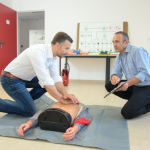How To Perform CPR on an Infant
How prepared are you when it comes to saving a life?
Whether you’re pregnant or have young ones of your own, knowing how to perform CPR is essential. Knowing how to do it properly can make the difference between life and death.
Not sure how to perform CPR on an infant?
We’ve got you covered! Listed below are the steps you should follow when trying to revive an infant using cardiopulmonary resuscitation. Keep reading for a CPR guide and more!
Gather Supplies Needed for Infant CPR
It is important to have the appropriate tools and supplies on hand in order to optimize safety and effectiveness. The supplies required for infant CPR include CPR face shields, a baby stethoscope if available, a hand sanitizing wipe, and latex or nitrile gloves. It is also important to remember to clear the infant’s airway prior to starting CPR.
A bulb syringe is a necessary tool to use to remove any mucus or vomit from the baby’s mouth before beginning CPR compressions. Lastly, place a small sheet or clean cloth should beneath the baby to protect the surface underneath from possible bodily secretions.
Position the Infant for CPR
To start, lay the infant on his or her back on a surface that is flat and firm. Kneel down on one side of the infant and place your dominant hand on the infant’s forehead to steady his or her neck and head. Put the other hand on the infant’s lower chest and tilt the head back slightly to open the airway.
If the infant is too small for two fingers to provide effective compressions, use the heel of your dominant hand, with the other helping to support the back of the head.
Perform Chest Compressions on the Infant
The compressions should be done with two fingers above the nipple line and 2cm deep at a rate of approximately 100 compressions per minute. Muscles and ribs are extremely delicate in infants, and proper technique must be used to avoid injury.
Performing chest compressions on an infant is a delicate and complicated task that requires specialized training and knowledge. To make sure you do it effectively, check out MyCPR NOW Group Discounts. They can help you get a certification to ensure that you do infant CPR properly.
Post-Rescue Care of the Infant
Post-rescue care of an infant who has undergone CPR is an important step for recovery. After a successful resuscitation effort, monitor the infant for at least 24 hours to ensure vital signs remain stable. Oxygen saturation should be monitored regularly, as oxygenation is a key predictor of an infant’s recovery.
Cardiac arrhythmias may need to be addressed. Monitor the infant’s growth and development to ensure progress is normal, and make sure to address any problems as soon as possible. With post-rescue care, the infant can hopefully make a full recovery and go on to lead a healthy life.
Learning How To Perform CPR on an Infant
CPR on an infant is an important skill and an invaluable resource in the event of a medical emergency. As long as the procedure is followed accurately and with confidence, the likelihood of saving a life is quite high.
Take steps today to learn how to perform CPR on an infant properly today. Find a local class or contact your local hospital for more information.
For more life guidance and CPR tips, we encourage you to continue your journey through the site.




